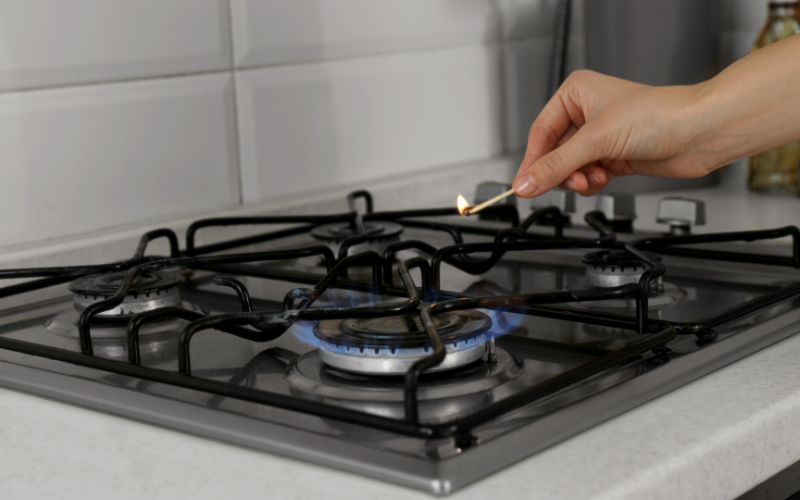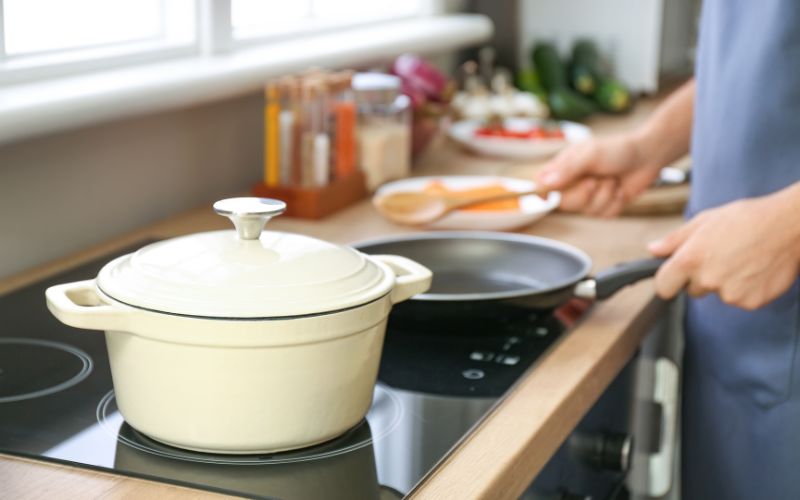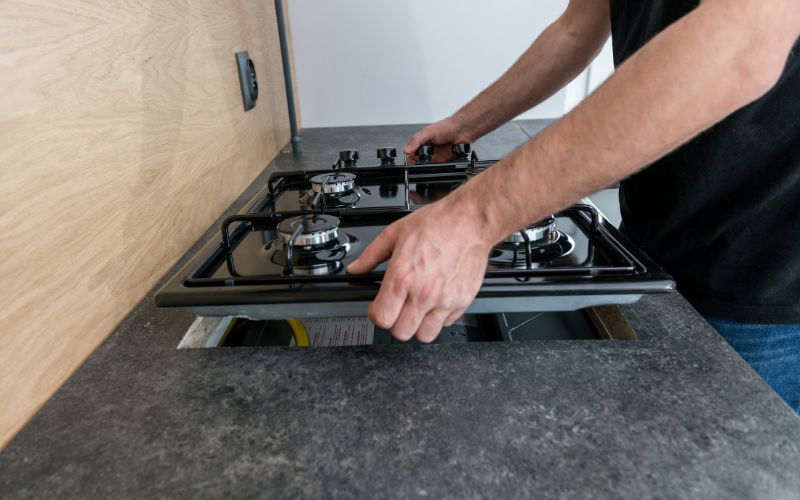If you need to find out whether your stove is gas or electric, you’re in the right place! We’ve got loads of advice on how to tell the difference between the two fuel sources so that you can concentrate on cooking up a storm.

How To Tell If A Stove Is Gas Or Electric
To tell if a stove is gas or electric, have a look at its cooktop. If it’s gas, the cooktop will have grates that sit on top of the gas burners. If it’s electric, it’ll either have a smooth, flat ceramic surface or metal, spiral-shaped coil heating elements.
Here are some other ways you can tell the difference between a gas and an electric stove:
1. Have a snoop around the back
If it’s a gas stove you’ll find a gas line and an electrical outlet at the back. The gas line is usually a flexible metal hose that connects the appliance to your home’s gas supply. However, if you have an electric stove, it’ll only have an electric outlet.
2. Check the controls
A gas stove may have a ‘light’ or ‘ignite’ setting that flicks the gas flame into action. Whereas an electric stove will have different temperatures and cooking settings that you can choose from.

3. Listen up and smell the coffee…I mean gas!
If you have a gas stove, you might be able to hear a sudden clicking, whooshing or poofing sound when you turn the dial to switch it on. Don’t panic though, these are all pretty normal sounds, it’s just the ignition lighting the flame and the gas moving through the pipes. Phew!
If you have an electric stove, you probably won’t hear anything. They’re pretty silent and aroma free too…that is until you’ve made your culinary masterpiece!

4. Look for a model number or brand
If you have the stove’s model number or brand, then a quick search online should be able to tell you more about its specification, including its fuel type.
5. Find the manual
You may need to rummage around a few cupboards or drawers for this one, but if you can track down the stove’s user manual, you’ll be able to find out its fuel type in no time.
6. Ask the landlord or homeowner
If you’re renting or staying at someone’s house for a period of time, it’s worth double-checking with the landlord or homeowner about the type of stove they have and how to use it. If in doubt, shout!

Can a stove be both electric and gas?
Yes, a stove can be both electric and gas, these appliances are called dual fuel ranges. They tend to have gas cooktops and electric ovens, giving people the best of both worlds. Dual fuel ranges tend to have large or multiple ovens, making them really versatile.
The dual fuel range benefits don’t stop there my friend, oh no! They also typically have more available gas burners on the cooktop, so you can have lots of different pans on the go. Imagine a pot of pasta to your left, a tasty tomato sauce simmering away on your right, and room in the middle to prep dessert. Easy!
Gas cooktops are really popular with chefs because of their precise and immediate heat control. This makes it easier to manage the cooking process, especially when you need to make quick temperature changes. They’re great for cooking with woks and other rounded pans because the open flame evenly distributes heat around the sides and base.
Electric ovens are great for keen bakers because they provide even and consistent heat, no soggy bottoms here! They’re also really versatile, as some models will include different cooking functions, like a convection fan and pizza settings, to name but a few.
However, one thing to bear in mind is their installation and price. Dual fuel ranges are big, so they need plenty of space first and foremost, as well as a gas line and an electric outlet to operate. You’ll need to make sure your kitchen can accommodate all of this. Also, dual-fuel ranges are more expensive than their single-fuel counterparts.

Does a gas stove need electricity to ignite?
Most modern gas stoves need electricity to ignite the flame in the oven. When you turn the stove on, the gas valve automatically opens and an electrical current flows through a heating element (glow bar). When it gets very hot (which is almost instantly) it sets the gas alight.
Modern gas stoves also need a certain amount of electricity to power things like lights, touchscreens, convection fans and smart features such as WiFI (if it’s super fancy)!
Can you manually light a gas stove with electric ignition?
You can only manually light a gas stove if it has a pilot light. This tends to be the case with older models. Modern stoves use a spark ignition which needs electricity to ignite the flame. So, if there’s a power cut you won’t be able to use it.
All is not lost though, as although this will leave the oven on your stove temporarily redundant, you should still be able to (carefully) light the gas burners on your cooktop using a match or lighter. Failing that, keep your take-out menus handy because it might be easier to leave the cooking to someone else whilst the power is off!

What’s better – A gas or electric stove?
The answer to this question very much depends on your personal preference, cooking habits and budget. Here are a few things to consider with both fuel sources.
Overall experience and control
As we mentioned above, gas is a favorite among chefs because of its precise and instant temperature control. It also produces more moisture, which is great for cooking meat. Think succulent sausages and juicy steaks!
If you’re more sweet than savory though, an electric stove is probably more your bag. As we touched on before, an electric stove’s oven provides a more even and consistent heat distribution, which is essential for light and fluffy cakes. Delicious!

Cost and energy efficiency
Gas stoves are usually less energy efficient compared to electric ones. However, natural gas is often cheaper than electricity, which can make operating a gas stove less expensive in some areas.
Installation
We mentioned earlier that a gas stove needs two elements to operate, a gas line and an electric outlet. If you’ve bought or inherited a gas stove but don’t have a gas line, installing one could be quite costly. Electric stoves only require an electric outlet, making them easier and less expensive to install.

Cleaning
The cooktop on a gas stove can be notoriously tricky to clean, thanks to the various nooks and crannies within the grates and burners. Electric cooktops with their flat ceramic surfaces are much easier to wipe down, but they can be susceptible to scratches and cracks. Yikes!

Safety
Obviously, with gas, there’s always the risk of a gas leak so it’s really important to get a professional to install it and to make sure it’s regularly maintained.
Electric stoves pose less of a risk as you don’t have to worry about an open flame. It’s still important to keep your wits about you though, as electric cooktops can take a while to cool down after they’ve been turned off, so maybe give it a while before you wipe it down. Ouch!
Is there an electric stove that looks like gas?
You can get electric stoves with some of the traditional aesthetics of a gas model. This look includes chunky dials and oven handles. There are also induction ranges which although electric, carry some of the same cooking benefits as gas.
For example, an induction cooktop gives you that all-important fast and easy-to-control temperature that gas lovers so enjoy when they’re getting creative in the kitchen. Looks wise, however, there are no grates or burners to admire but look on the bright side, at least the clean-up will be easier with that beautiful flat surface! Yes!
If you have a cool $6000 to spend, this induction range may be just the ticket. It’s got the traditional design elements of a gas stove with chunky dials and handles. Plus, some of the benefits of gas cooking with the induction cooktop, as well as all of the plus points of an electric stove. And it’s all wrapped up in a fresh and fruity burgundy shade. Nice!
